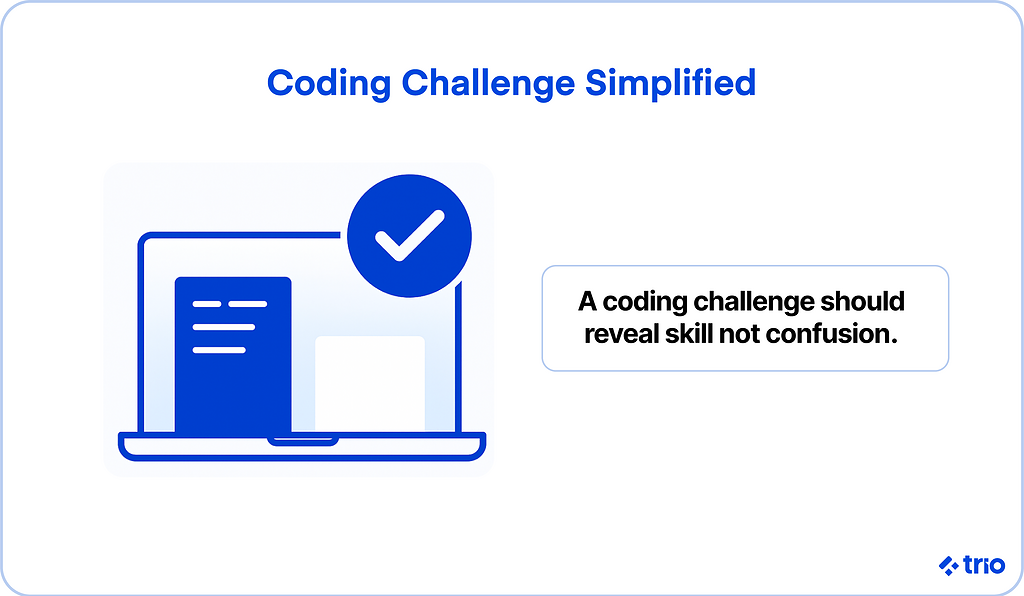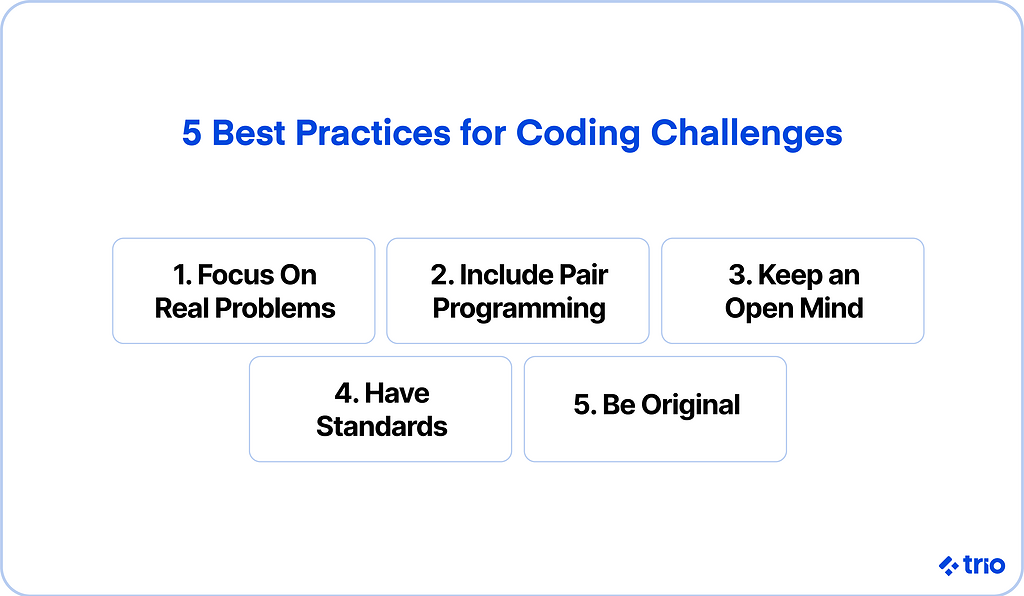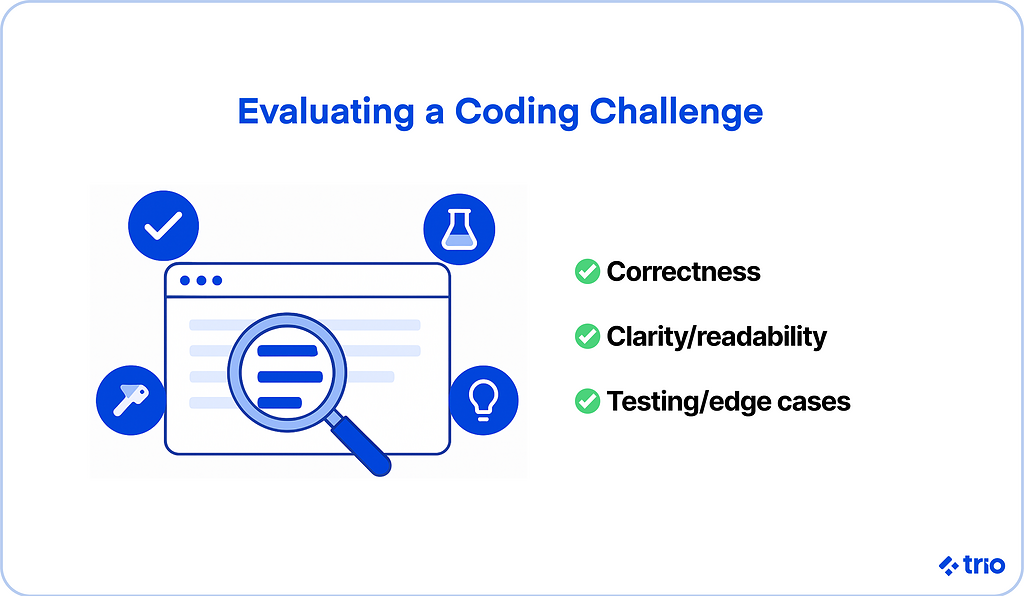Finding and hiring the right developer for your team can be a challenging task. Many organizations use coding challenges in their interview process to assess which developers truly excel.
The only issue is that many of these organizations administer interview coding challenges incorrectly.
Proving competency in software development takes more than solving a few trick questions. But this is what many companies do regardless.
On the other side of the table, developers often feel unprepared or anxious about these challenges. Without a clear strategy, even skilled programmers can struggle not because they lack ability, but because the process itself is unfamiliar.
A coding challenge is used to determine what kind of employee you might be hiring.
A coding challenge is used to determine what kind of employee you might be hiring.
It illustrates a software engineer’s technical skills, their approach to problem-solving, and their ability to understand requirements and think clearly under pressure.
Ensuring that the coding challenge realistically reflects the goals and tasks that applicants would face in the workplace significantly increases the chances of hiring the best developer for the job.

Learn more about how to create your own coding challenge here. We’ll draw on our experience building and scaling engineering teams, and show you not only how companies can design fair and effective coding challenges, but also how developers can approach these challenges strategically.
Are you ready to start your development project?
We have the developers you need to take your development project in the right direction.
Companies are proven to grow their business faster with Trio.
What Are Coding Challenges?
Coding challenges are precisely what they sound like. They are a means of testing a software engineer’s gifts in front of a monitor. Coding is the mainstay of a software developer’s responsibilities, so it is essential to ensure your job candidate can program efficiently.
While some professional industries rely on a series of talk interviews to learn more about a job candidate, other industries stress the importance of finding candidates who can handle the job by putting potential employees right into the environment they will be working in.
The educational sector, for example, uses teaching demonstrations to determine whether a candidate has the aptitude to effectively teach a topic to a class. When it comes to software development, there are coding challenges.
Sometimes, the coding challenge is presented in the format of a take-home test. At other times, developers will code in front of recruiters to get a better idea of how potential employees approach the challenge.
Beyond hiring, coding challenges are also a powerful tool for developers themselves.
Many programmers use platforms such as CodeWars, LeetCode, HackerRank, and Project Euler to sharpen their skills, learn new algorithms, and prepare for technical interviews.
Challenges can take many forms: timed online assessments, open-ended project tasks, or live pair-programming sessions. Each format tests different aspects of coding ability, from speed and syntax fluency to collaboration and long-term problem-solving.
What Are the Advantages of Interview Coding Challenges?
Coding challenges as an interview form carry a number of benefits. Besides simply testing your job candidates, there are discernible features of a coding challenge that make it better than just any traditional interview.
Trio does coding challenges throughout the hiring process. Initial interviewing begins with a small coding challenge, and later, more technical interviews involve a more intensive challenge.
The co-founder of Trio, Daniel Alcanja, asserts that:
“It’s very important to watch how [a developer] codes, and how [a developer] is thinking about the problem.”
Here are some advantages of coding challenges.
We’ve already covered a lot of this, but let’s group all the reasons coding challenges are critical together in an easy-to-read format:
For Developers
- Skill Growth: Regularly solving coding challenges helps developers improve fluency in algorithms, data structures, and real-world problem-solving.
- Interview Preparation: Most technical interviews rely on challenges. Practicing in advance reduces anxiety and helps candidates perform with confidence.
- Portfolio Building: Completed challenges can serve as tangible evidence of ability, especially when shared on GitHub, personal blogs, or platforms like LeetCode.
- Confidence and Creativity: Each solved challenge reinforces problem-solving confidence and fosters the creativity needed to tackle new, unfamiliar problems.
For Employers
- Predictive Value: A thoughtfully constructed challenge is one of the best indicators of how a candidate will handle the actual tasks of the job.
- Objective Assessment: Unlike conversational interviews, coding challenges provide measurable data on how candidates actually perform under realistic conditions.
- Hiring Efficiency: Well-designed challenges save time by quickly filtering out candidates who are not technically prepared.
- Culture Fit and Collaboration: Pair programming challenges reveal how a developer communicates, thinks through problems, and collaborates with peers.
How to Solve Coding Challenges (Step-by-Step)
From a developer’s perspective, having a repeatable, structured process increases your chances of success. By approaching each challenge methodically, you reduce stress and improve your chances of solving problems efficiently.
Here’s a framework you can follow:
1. Understand the Problem
Carefully read the problem statement.
Ensure you understand the input, output, and any constraints. Look at sample test cases to clarify what’s expected. If this were an interview setting, ask clarifying questions rather than making assumptions.
2. Plan Your Approach
Before typing code, pause and think.
Break the problem down into smaller subproblems, identify the necessary data structures, and consider potential edge cases. This step saves time and reduces wasted effort.
3. Write Pseudocode
Translate your plan into simple step-by-step instructions, written in plain language.
Pseudocode helps organize your thoughts and ensures that you don’t skip any key steps.
4. Write the Code
Turn your pseudocode into real code.
Use a language you’re comfortable with, write clean and readable variable names, and stick closely to your plan. Efficiency matters, but clarity comes first.
5. Test Thoroughly
Start with the provided test cases, then add your own, especially instances of edge cases like empty inputs, maximum values, or unusual conditions. Debug your code systematically if it doesn’t behave as expected.
6. Optimize and Refactor
Once your solution is working, look for opportunities to improve it.
Can you reduce the time complexity from O(n²) to O(n log n)? Can you use less memory? Refactor messy logic into cleaner functions or modules.
7. Reflect and Learn
After solving, take notes: What worked well? Where did you get stuck? Could you have chosen a better algorithm?
Over time, this reflection builds stronger problem-solving skills and reduces mistakes in future challenges.
5 Best Practices for Creating Coding Challenges
To get the most from a coding challenge, it must mirror a real-life software development concern. Challenges can include finding a bug in a problematic piece of code or building out a new feature and integrating it.
The coding challenge should have clear goals and measurement systems to objectively quantify a candidate’s performance. Coding challenges save the hiring company time while showcasing the technical skills of the candidates involved.
Here are five best practices that Trio has developed from years of building and scaling engineering teams:

1. Focus On Real Problems
Giving candidates real-life problems to solve will show how well they will do on the job and what impact they could have at your company. You can use the challenges that your business has overcome in the past or the issues your business is currently facing.
These challenges will be more relatable than complex trick questions. It will also provide the candidate with an idea of what they’ll see on the job. This way, they can also see if they’re a good fit for the position.
Generic coding challenges won’t be a good fit because they don’t target the specific skills that you are looking for or the particular problems that your business will face.
The more specific you get, the better fit for the job you will find among your candidates.
Tip: Avoid algorithm puzzles lifted from the internet. These often frustrate candidates and don’t reflect real-world work.
2. Includes Pair Programming
Pair programming is a type of screening process where your interviewer reviews each line of code as the developer writes it.
It is an interactive process where the candidate walks the interviewer through their thought process and explains how they solve the problem.
Pair programming is an excellent way to see how your job candidate collaborates. Collaboration is an essential skill for a great developer.
This practice also gives candidates the opportunity to ask clarifying questions. This is a valuable sign that they think critically and communicate effectively.
3. Keep an Open Mind
Getting the ‘right’ answer is not the only goal of a coding challenge.
A good problem will always have multiple solutions. The coding challenge is an opportunity to see how a candidate thinks and approaches the issue.
If they didn’t reach a viable solution, you can still see their skills in action and identify areas that might require some improvement. How a developer meets requirements and dissects the problem is what matters most.
Remember: a candidate’s process and reasoning are often stronger indicators of future performance than the final answer.
4. Have Standards
Put job candidates on the same level by standardizing your coding challenge. Each developer should work on the same problem, with the same tools, and, if possible, with the same interviewer.
This helps to evaluate all applicants equally and simplifies the analysis of the results. If you have too many different variables, you might not be able to compare each candidate’s performance objectively.
Establishing a standard evaluation rubric (clarity, correctness, testing, collaboration, problem-solving) makes hiring decisions faster and more objective.
5. Be Original
Don’t rely on coding challenges that come right out of the box. These can and have been reused, making coding challenges less of a challenge and more of a multiple-choice test.
Stick to using real-life problems that your business has encountered. Websites such as Glassdoor can also indicate if your test has been shared online.
Original challenges protect you from leaked solutions and also provide candidates with a positive experience.
How To Evaluate the Results of a Coding Challenge?
The idea of a coding challenge is to find the best developers and distinguish them from those who are not qualified for the job. So when the coding challenge is complete, how do you evaluate the results?
Remember why you’re hiring for that specific position and how each candidate met the requirements of the challenge. Evaluate candidates’ process based on the steps they take to address the challenge.

You should consider the work priorities that your team has. For example, if test-driven development is a priority, look at the job candidate’s unit test(s).
Make sure that a candidate has a clear understanding of the challenge requirements. Did they grasp all the details? Were they willing to ask for clarification to complete the problem? Were their mistakes due to a misunderstanding or to a lack of attention to detail?
After the challenge is complete, take some time to discuss it with the candidate, allowing them to explain their decision-making process and how they handle criticism of their work.
While skills can be improved, an inadequate response to feedback or an inability to discuss the project and its results is a red flag. If possible, try to provide feedback, even if you think the developer is not a good match for your company.
Adding structured evaluation criteria makes this process far more consistent. We recommend a rubric that evaluates:
- Correctness: Does the code work as intended and pass test cases?
- Clarity: Is the code readable, well-structured, and logically organized?
- Testing: Did the candidate test edge cases and validate their solution?
- Problem-Solving: How effective was their approach to breaking down the problem?
- Collaboration: Did they communicate their thought process clearly during live challenges?
There is a polite way of handling the hiring process. Thoughtful feedback provides the candidate with an overview of their performance and an indication of where they can improve in the future. By providing candidate feedback, you are doing them a favor and helping them grow.

Elevate Your Team with Trio AI Talent
Empower Your Projects with Trio’s Elite Tech Teams
Conclusion
Coding challenges can help you filter out the highest-quality engineers for your business. This will launch them into the day-to-day responsibilities of a professional software developer.
Trio uses specialized coding challenges to evaluate the developers we hire. With our process, you can trust that Trio developers know best and give you the best of their work.
FAQs
What are coding challenges?
Coding challenges are timed or structured problems that test a developer’s programming and problem-solving skills.
Why are coding challenges important?
Coding challenges are important because they enable employers to assess candidates fairly and allow developers to refine their skills.
How do I prepare for coding challenges?
To prepare for coding challenges, start with simple problems, practice regularly, and learn from the solutions of other developers.
Which platforms are best for coding practice?
The best platforms for coding practice include CodeWars, LeetCode, HackerRank, Project Euler, and HackerEarth.






